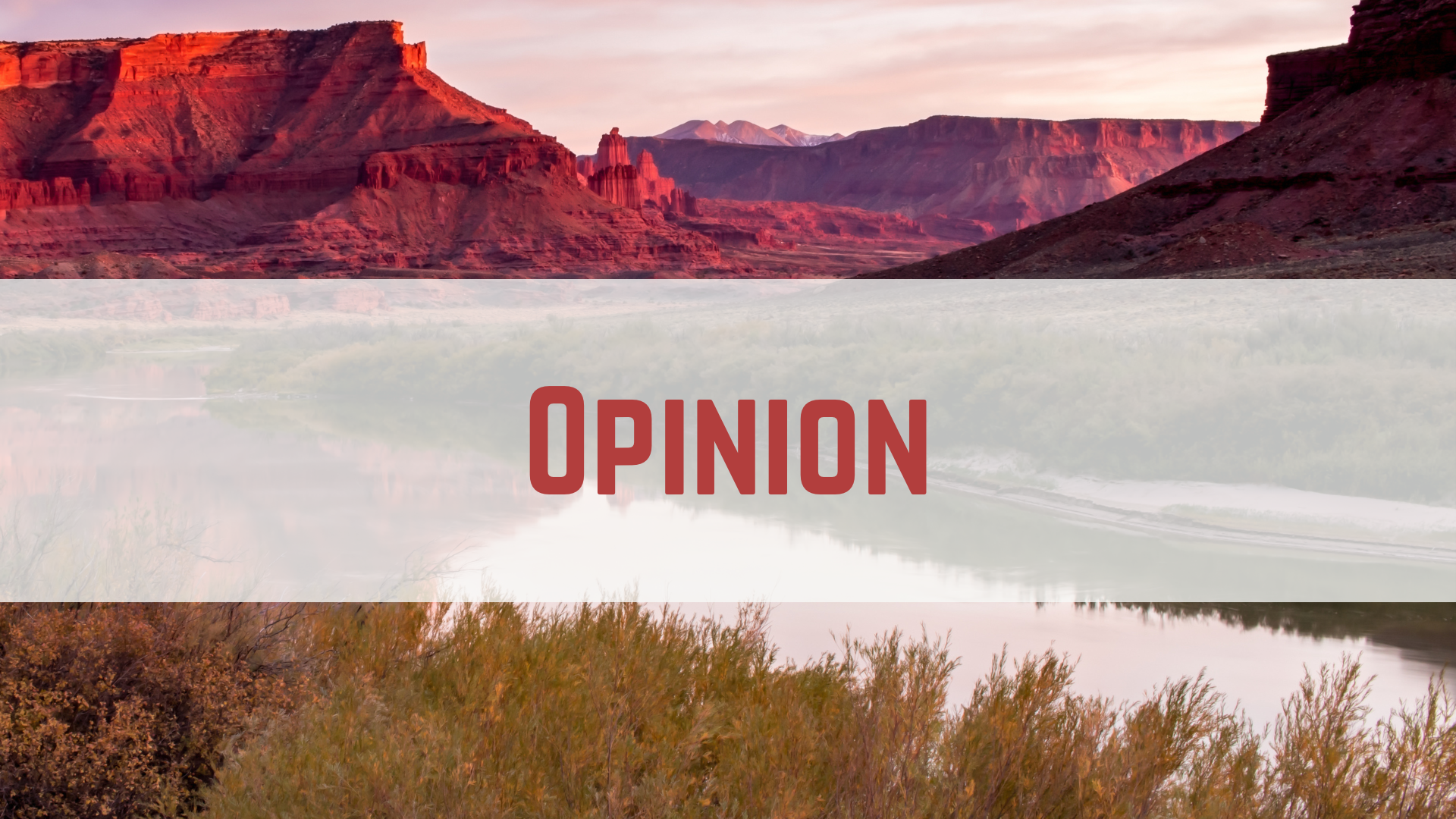Some information may be outdated.
If you squint at the wall of Green River Coffee Co, you’ll see a photo of two men in a big field delivering shovel blows to each other, with the caption: “discussing water rights, a western pastime.” Bringing up water issues to Westerners, I’m often met with sighs of exasperation or silent commiseration.
Water rules human movement and settlement. Aquifer levels in the Moab Valley, access to sources like Matrimony Springs, and rights to the Colorado River have all been brow-raising water topics in recent years.
In the river-running community, the construction of Glen Canyon Dam and the creation of Lake Powell half a century ago marked a drastic ecological and recreational shift in southern Utah.
However, the mood at Howling for Glen Canyon, a two-night gathering “of merriment” at John Wesley Powell River History Museum on May 10 and 11, struck a chord of wonderment instead of despair.
Bearing witness to changes since Glen Canyon Dam’s construction in 1966, guest artists celebrated southern Utah’s dynamic labyrinth written into rock by the Colorado River. The event closed out the museum’s year-long exhibit, Glen Canyon: A River Guide Remembers, produced by Ryann Savino.
“It’s about rebirth and rejuvenation,” said Eric Balken, executive director of Glen Canyon Institute, one of the museum’s event partners. Water levels in the canyon have fluctuated since the dam’s construction, transforming biology, geology, and culture in the region. Rocks and passageways submerged by Lake Powell are revealing themselves with the lake’s recent decline. Savino and Balken agreed the exhibit and performances invite the river community to consider our place in natural preservation efforts.
“We would like to see Glen Canyon returned to its former natural beauty,” Museum Director Janet Smoak said, ending a pre-show land acknowledgment with hope. She was received with howls from an audience dispersed through her exhibits.
“The preservation of place is inextricably tied to the preservation of stories,” Savino said to a sizable crowd before Greg Istock and Craig Childs’ Blood River show. Her exhibit, produced by Martha Ham, chronicled a 1959 river trip led by Ken Sleight, a river-running icon who operated Wonderland Expeditions. His documentation provides a reminiscence of pre-dam Glen Canyon, the exhibit ending with a quote from Sleight and his wife Jane, “Farewell Glen Canyon… to remember what was lost.”
Craig Childs’ silhouette at Blood River, a performance at John Wesley Powell River History Museum on May 10th, 2024. photo by Nath Kapoor
Balken also introduced Istock and Childs’ performance with his first memory of meeting Childs before a river trip. He recounted his own nerves about keeping up with the program of such a seasoned explorer, to which Childs replied, “I just grab a notebook, get out there, look around, and I say ‘Whoa!’”
Childs shared stream-of-consciousness style prose from recent canyon trips while Istock riffed an electric guitar and interspersed Childs’ with lyrics of his own. Photos and videos of the canyon projected behind their collaboration.
“Change is what the world is made of,” the evening’s mantra, rang out from a chorus of audience members when Istock invited us to sing along. Childs substantiated this hymn with ballads of gravity moving rock with water, of his mother running the river, and of his archaeological curiosities about Lake Powell’s old reemerging trash.
Childs’ stories surprised me. Most naturalists I’ve encountered obsess over environmental purity and preservation, solitude and natural beauty. Childs seemed more excited by energy itself, which he pointed out is constantly flowing through the canyon. Childs daydreamed about this same energy flowing across the canyon’s rim on Highway 95 in the form of car traffic fueled by ancient life; or in metropolises at the base of our waterways like Los Angeles and New York, whose skyscrapers form canyonlike geography teeming with a diverse biosphere.
“I like to see the bones of things,” Childs said. “The bare bottom before spring flows.” He showed us a picture of a stairwell carved into canyonside and emerging from the Colorado, probably leading to bygone Indigenous cliff dwellings. His eyes and arms came alive with imagination about a people whose soul still whispers; what would their world look like if we descended those stairs, into their otherworld?
“There are stories the river will never tell,” Istock answered Childs with lyrics from Blood River, a song inspired by Childs’ own writings. I felt hypnotized by the two men’s synergy and excited by how their message played upon messages from earlier in the night. Museum staff and curators framed Glen Canyon as a site of hope, loss, and preservation, while Istock and Childs guided us down to a place of a radical faith in change itself.
Savino masterfully showed us how “the preservation of place is inextricably tied to the preservation of stories” by curating the records of Ken Sleight. Childs showed us how gravity and mankind meet to reimagine a place, eroding its stories into an otherworld for safekeeping.
I left the performance puzzled. I wanted to speak with Childs after, but got the feeling he had said his piece already, so I wrestled with my own questions. What is the most meritable way to approach a place like Glen Canyon? Do we focus on preserving what we know, or letting go of the past and submitting to gravity’s force of grief?
Childs helped the following morning. It was a passage from his book Soul of Nowhere: Traversing Grace in a Rugged Land, as he reflects on a forest chasm in Northern Mexico:
“I imagined that this must be what every person desires most. Maybe not this place in particular, but this sensation. It is what we mean by immortality. Not to live forever, but to pass into something that does.” (Childs, Soul of Nowhere, pg. 20)
Maybe awe is the sixth stage of grief, achieved when we glimpse beyond our assumptions about loss. In small canyon cracks, ancient stairwells, and the eyes of people of whom you bear witness to yourself, squint and see the truth.
“Rivers never die,” Childs said towards the end of Blood River. “They just need water to flow.”
A few coworkers and I drank Pacificos and splayed ourselves on the warm sand at Six Mile Beach a week after Blood River. It was Friday afternoon and the eddy stripped work off of us. Britt, one coworker, mentioned how the Six Mile sandbank changes with every monsoon.
“Storms have been a great teacher,” Britt said. We talked about how monsoons make a place unrecognizable in minutes, the rocks above take eons to become unrecognizable, and change comes over us at every speed between, always. She stood knee-deep in the eddy and watched the water come down with reverence.
Appreciate the coverage? Help keep local news alive.
Chip in to support the Moab Sun News.



